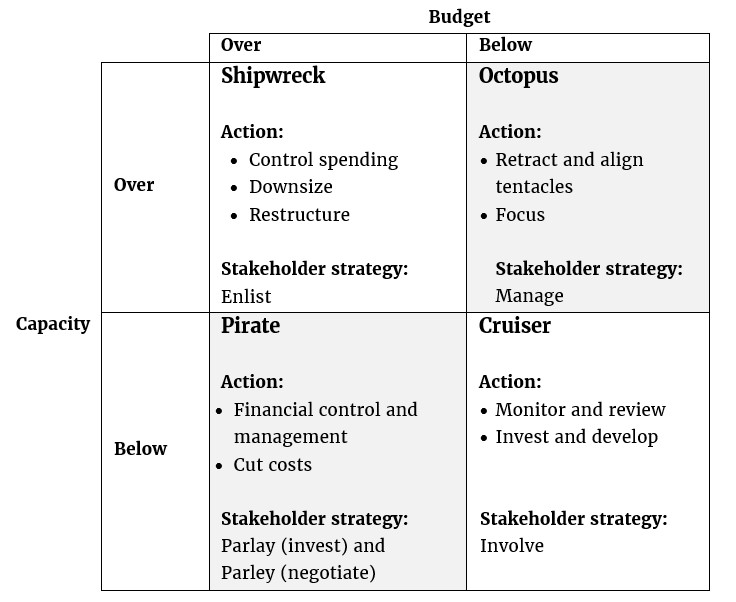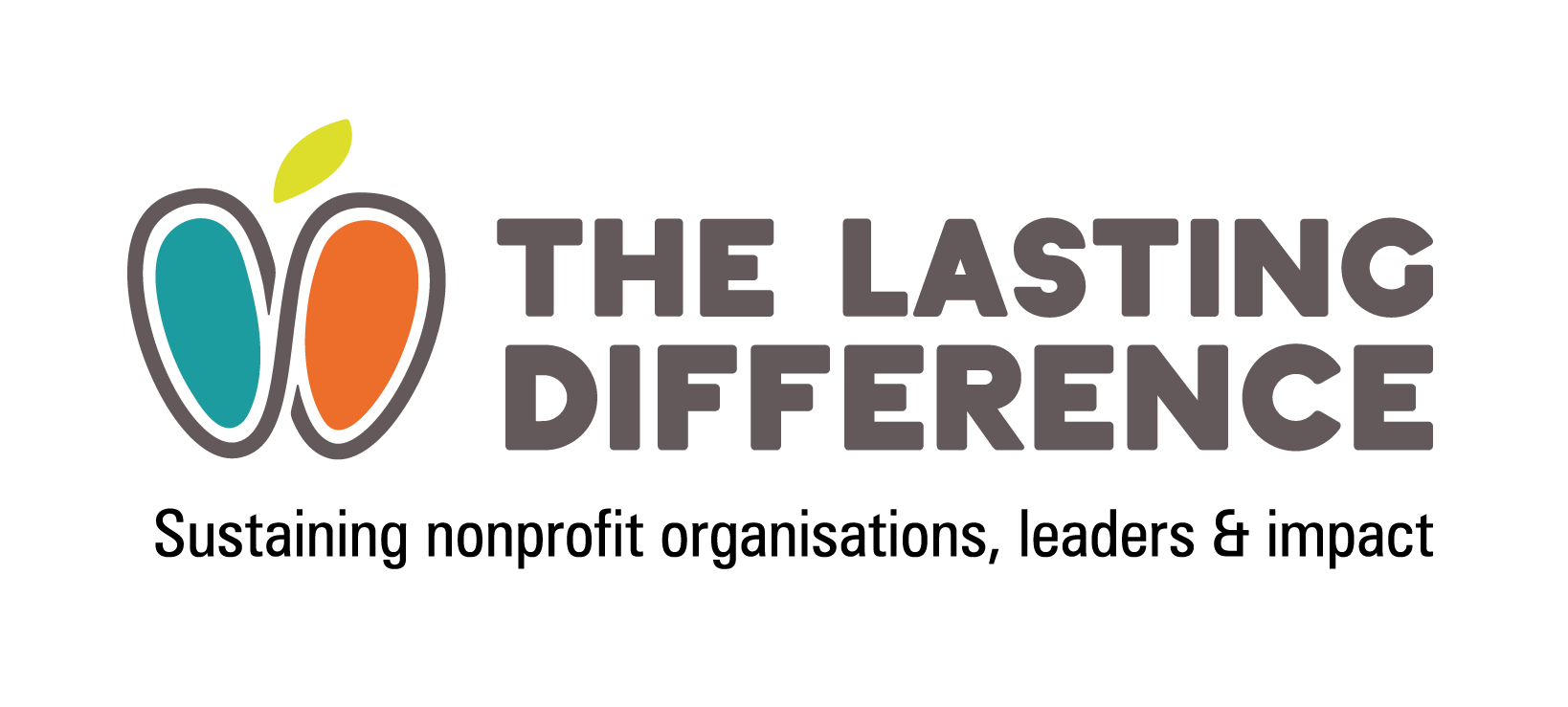Over the last five weeks I’ve explored the four paradoxes of sustainability:
- The Change paradox: Only by changing can organisations be sustainable.
- The Yes/No paradox: The things that an organisation needs to survive can also kill it.
- The Efficiency paradox: Efficiency preserves resources but can impair development.
- The Octopus paradox: Organisations need to reach out in new directions to grow. But growing in too many directions pulls them out of shape.
Two recurring themes within each of these are budgets and capacity. In my new book ‘Making a Lasting Difference’, I spend a chapter looking at some of the links between the two, and how they can be managed. I’ve reproduced the chapter here in full, selfishly to encourage you to read the book, and altruistically to thank everyone who cast a vote to choose the book’s title. ‘The Octopus and the Shipwreck’ came a close second (and was my personal favourite!) so I promised those of you who voted for that title a little bonus. Here’s what it is all about.
This matrix and the descriptions below set out different scenarios that occur in relation to budgets and capacity. They can be used to assess an organisation’s position – and take action on it.

Over budget, over capacity: Shipwreck
Description
It might not be shipwrecked yet, but the organisation is heading for the rocks at full throttle. It might be over budget because of poor planning or financial control, or because staff are working above capacity. It might be undercharging for its work or underestimating its true costs. The organisation has possibly had to respond to unexpectedly high levels of demand (incurring direct costs like staffing, project resources etc.), and/or taken on things it should have said no to. This is an unsustainable position. Quality, safety and staff wellbeing are at risk, as is the organisation’s reputation (at best) and its future (at worst).
Action: Control spending, downsize, restructure.
Urgent action is needed to steer the ship away from the rocks. Seeking emergency funding might help to ‘bail out’ the ship but this may take more time than the organisation has. In the short-term, spending needs to be brought back under control, which means reviewing commitments including possibly stopping some areas of activity if required. If extra funding (and the capacity it brings) isn’t found, the organisation will need to downsize and restructure. Crucially, new plans and controls will be needed to avoid repeating the situation in future.
Stakeholder strategy: Enlist
Enlisting stakeholder support is essential. Stakeholders, both internal (e.g. staff, clients, volunteers) and external (e.g. referrers, funders, partners, communities) will want to understand what has happened and why. Honest engagement is needed to enlist their support in sustaining the organisation. Can they help with capacity? Can they help with funding? Are they prepared to give the organisation time to turn things around?
Over budget, below capacity: Pirate
Description
This organisation has overspent its budget but has capacity to spare, which could indicate a number of things. It may be that it has invested in infrastructure (staffing, premises, IT etc.) but the work hasn’t developed as planned (e.g. partnerships might still be developing, referrals might be awaited). There might be poor financial management and control. Or it may be carrying too many staff and unnecessary overheads.
Action: Control finances, cut costs. Use spare capacity or lose it.
Financial control is needed. A plan should be developed for bringing finances and capacity back into line with each other. Budgets and structures should be reviewed to find savings and costs should be cut accordingly. Spare capacity that has already been paid for can be put to use to generate income (e.g. hiring out under-used premises or resources; assigning staff to developing business and generating income).
Stakeholder strategy: Parlay/Parley
Two similar words with different meanings are useful here. The first, parlay, means to invest or gamble profitably. The pirate has spent money and accumulated resources but it remains to be seen if, or maybe how, the investment will pay off. Stakeholders could feel they have been robbed by the pirate and want to know where the treasure is buried.
So, ‘parley’ is required: a word from pirate folklore (or French?!), meaning to talk and negotiate. Organisations in this situation should ask stakeholders for a parley, negotiating to show they are trustworthy and, if necessary, can change their ways. Are investors and donors happy for the pirate to have spare capacity? Maybe they are glad that this ensures a healthy level of quality, safety and insurance against future risks. Or do they want to see more for their money? Are beneficiaries feeling let down by a lack of service, or are they getting a very high-quality service that makes up for it? How will they feel if this changes, for example if the service gets stretched more thinly when demand increases, or if it gets cut to bring finances under control? The sustainability of piracy as an occupation will depend on the answers to these questions. But it’s a questionable strategy for a non-profit organisation.
Below budget, over capacity: Octopus
Description
Financially, this organisation is working within its means. But it has over-committed in terms of capacity, appearing to have taken too much on. This might be short-term – the octopus might recently have used its tentacles to bring in extra resources to increase capacity, but these have yet to be deployed. It might have a frugal financial controller who doesn’t want to release money for extra capacity, letting the burden be carried by staff or services elsewhere. It may have a prudent strategy of saving to invest in a new direction or development. But its ability to attend to this could be hampered by having spread its tentacles in too many directions.
Action: Retract and align tentacles. Focus.
The octopus is possibly engaged in a successful strategy but needs to assign its spare resources to increase its capacity or retract one or more of its tentacles. Either way, in the short-term it should recognise and deal with organisational overload before growing new tentacles. Longer term, it should focus on the direction it wants to go in and ensure its tentacles are aligned with this – and with each other.
Stakeholder strategy: Manage
Involving funders, partners and beneficiaries effectively is one of the core Sustainability Capabilities for a good reason (see Part 3). Stakeholder involvement can provide intelligence and insight to help the organisation adapt. But if the octopus has been pulled out of shape by stakeholder expectations, it should make sure it manages these effectively. This requires honest conversations about the limits and strains on capacity and the way that stakeholders affect – or could be affected by – this.
Below budget, below capacity: Cruiser
Description
With capacity and budget to spare, this organisation can take time to explore the world around it. It can invest in new developments. Having healthy capacity and budgets should be signs of a well-run organisation. It is also possible that cruisers are in the early stages of development, or indeed that they are not yet clear on, or are losing sight of, their purpose. This situation can arise when, for example, an organisation is created (or receives an injection of income) in response to a new government policy.
However, with the risk of being an organisation in search of a purpose, the cruiser could drift off course. Research shows that organisations and people are at their most innovative when they are under some pressure to perform (technological advancements during wartime are an oft-cited example). So purposeful exploration is the key. It is unlikely any organisation can cruise for long, so time spent in this quadrant is to be appreciated but not squandered.
Action: Monitor and review, invest and develop
Working within budget and with spare capacity should be signs of organisational health. Cruisers should monitor and review their situation to reassure themselves and their stakeholders that they are still on course towards their objectives. If this is the case, they should take the opportunity to invest spare resource and capacity in developments that will help them survive less tranquil waters. Managers and staff often have undeveloped ideas for projects and innovations, just waiting for the time to explore and implement them. Now is that time. For example, a common sustainability challenge is about how to manage growth – how do organisations scale up a successful delivery model or transfer it to a new area, without taking their eyes off the ball and putting existing activity at risk? This should be less of a conundrum when there is spare capacity in the team. Spare budget could be used to recruit staff (to develop the new area or provide cover for existing services), commission a feasibility study, or run a pilot.
People should be encouraged to recognise this as an important opportunity to build capacity for the future, and to get on with developing the new products, services or approaches they have dreamt of. More mundanely, it might be that the organisation can invest in new stock and equipment, again provisioning it for future opportunities and challenges.
Stakeholder strategy: Involve
If cruisers are not on course towards their objectives it makes sense to involve stakeholders in checking and redirecting them. Similarly, if things are going well for good reason, this is an ideal opportunity to involve stakeholders in conversations about the future. Time and resources should be available for consultations, evaluations, stakeholder engagement events, service reviews, planning meetings, away days – things that are always useful but are usually less pressing than operational demands.
It is likely that when things are going well, stakeholders and sustainability will be overlooked. But now is exactly the right time to excite people around a vision for the next stage in the organisation’s development. If organisations wait until things are on a downward curve before they promote their vision and enlist support, they become a much less attractive prospect for people to invest their time, money and effort in. It is much more attractive for supporters to invest in a positive vision for the future than to fill a hole.
This is an excerpt from my new book, Making a Lasting Difference. Published by Wren and Greyhound, it is available as a 220 page paperback for £14.99 from Flying Underground and from Amazon, where it is also available for Kindle (£4.99).
